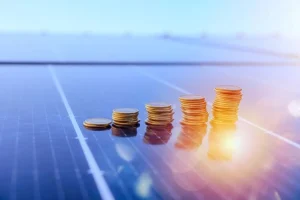Solar Tax Rebates and Incentives in Singapore

Solar rebates and incentives have made the switch to solar energy an attractive option for businesses and landed property owners in Singapore. The government and other organizations offer various incentives to encourage the use of solar power, these incentives and benefits can help businesses and landed property owners save money and reduce their carbon footprint.
One of the most significant incentives for businesses and landed property owners in Singapore is the SolarNova programme. This programme provides a co-funding grant of up to 50% of the cost of installing solar panels to eligible organizations. The grant is capped at SGD 20 million per project, and the programme aims to achieve a solar capacity of 350 megawatts-peak (MWp) by 2020. The SolarNova programme has helped many businesses and landed property owners in Singapore to switch to solar power.
Source: Energy Market Authority – Guide to Solar PV
SolarNova Programme
Apart from the SolarNova programme, the government also offers the Enhanced Net Energy Metering Scheme (ENEMS) to businesses and landed property owners. The ENEMS allows consumers to sell excess solar power generated by their solar panels back to the grid at a higher rate. This scheme ensures that businesses and landed property owners can make the most of their solar panels and earn a higher return on their investment.
In addition to government incentives, there are several other rebates available to businesses and landed property owners who install solar panels. For example, the Energy Market Authority (EMA) offers a rebate of up to SGD 10,000 for the installation of solar panels on commercial buildings.
Furthermore, businesses and landed property owners can take advantage of the enhanced capital allowance (ECA) scheme, which allows them to claim tax deductions for the capital expenditure incurred on installing solar panels. The ECA scheme provides a tax deduction of 100% of the qualifying expenditure in the year of assessment.
Overall, solar rebates and incentives have made solar energy an attractive option for businesses and landed property owners in Singapore. These incentives can help organizations save money and reduce their carbon footprint while promoting sustainable energy practices. By taking advantage of the available incentives and rebates, businesses and landed property owners can make a significant contribution to the country’s efforts to promote the use of renewable energy. If you wish to install solar panels for your home or businesses contact us or check out the best value solar panel brands in Singapore now!
| Questions | Answers |
|---|---|
| What is the SolarNova programme? | The SolarNova programme is a government initiative launched in 2014 to promote the use of solar energy in Singapore. The programme aims to achieve a solar capacity of 350 megawatts-peak (MWp) by 2020 and provides a co-funding grant of up to 50% of the cost of installing solar panels to eligible organizations. |
| Who is eligible for the SolarNova programme? | The SolarNova programme is available to businesses, institutions, and government agencies in Singapore. Eligible organizations must have a minimum of 20 kilowatts-peak (kWp) and a maximum of 5 megawatts-peak (MWp) of solar energy capacity. |
| What is the maximum grant amount under the SolarNova programme? | The co-funding grant provided under the SolarNova programme is capped at SGD 20 million per project. The grant covers up to 50% of the cost for solar panel installation, with a maximum cap of SGD 1.2 million per project per year, whichever amount is less. |
| How can organizations apply for the SolarNova programme? | Organizations can apply for the SolarNova programme through a competitive bidding process. Interested organizations must submit a proposal that meets the eligibility criteria and demonstrate the technical feasibility and financial viability of the project. |
| What are the benefits of the SolarNova programme? | The SolarNova programme provides a co-funding grant to eligible organizations, making the switch to solar energy more affordable. By installing solar panels, organizations can save on energy costs, reduce their carbon footprint, and contribute to Singapore’s efforts to promote sustainable energy practices. |
Green Mark Incentive Scheme for Existing Buildings
2.0(GMIS-EB 2.0)
| Green Mark Certification Level | Funding Factor ($ per tonne of CO2e) | Funding Cap |
|---|---|---|
| Green Mark Platinum | $25 | $600,000 or 50% of costs |
| Green Mark Super Low Energy | $35 | $900,000 or 50% of costs |
| Green Mark Zero Energy | $45 | $1,200,000 or 50% of costs |
Eligibility:
- Privately-owned existing buildings with a Gross Floor Area (GFA) of at least 5,000 square meters.
- Applicable to various building types, including commercial and institutional developments, light industrial buildings (with specific criteria), and residential buildings (for common area/services energy savings).
- Available until funds are fully committed or by March 31, 2027, whichever is earlier.
In March 2021, the Building and Construction Authority (BCA) in Singapore launched the Singapore Green Building Masterplan (SGBMP) to promote environmental sustainability and reduce carbon emissions in the construction sector.
As part of this plan, on June 30, 2022, BCA introduced the Green Mark Incentive Scheme for Existing Buildings 2.0 (GMIS-EB 2.0). The goal of this scheme is to improve the energy efficiency of existing buildings and make them more environmentally friendly. The aim is to make 80% of buildings in Singapore green by 2030.
GMIS-EB 2.0 offers financial support to building owners who want to upgrade their buildings to be more energy-efficient. This financial support helps cover the costs of making energy-efficient improvements to existing buildings and makes it more attractive for building owners to invest in such upgrades.
The scheme provides different levels of financial support based on the Green Mark certification rating and the extent of carbon emissions reduction achieved through Energy Improvement Works (EIWs). There are three levels of Green Mark certification that determine the funding support:
- Green Mark Platinum: This is the highest level, and building owners can receive $25 per tonne of carbon emissions reduced, with a funding cap of $600,000 or up to 50% of the qualifying cost, whichever is lower.
- Green Mark Super Low Energy (SLE): Building owners can receive $35 per tonne of carbon emissions reduced, with a funding cap of $900,000 or up to 50% of the qualifying cost, whichever is lower.
- Green Mark Zero Energy (ZE): This is the most energy-efficient level, and building owners can receive $45 per tonne of carbon emissions reduced, with a funding cap of $1,200,000 or up to 50% of the qualifying cost, whichever is lower.
To be eligible for GMIS-EB 2.0, your building must be privately-owned and have a Gross Floor Area (GFA) of at least 5,000 square meters. The scheme is available for various types of buildings, including commercial and institutional developments (like hotels, offices, and healthcare facilities), light industrial buildings (with specific criteria), and residential buildings (for energy savings in common areas/services).
It’s important to note that the scheme is available until the allocated funds have been fully used or until March 31, 2027, whichever comes first.
In summary, GMIS-EB 2.0 is a program in Singapore that provides financial incentives to building owners who want to make their buildings more energy-efficient and environmentally friendly. The level of support you can receive depends on the Green Mark certification level and the carbon emissions reduction achieved through energy improvements.
Selling Excess Solar-Generated Electricity
If you have a solar power system generating less than 1 megawatt (MWac) of electricity and you’re not part of a competitive market, you can sell the extra electricity it produces. To do this, follow these simple steps:
- Download and fill out the Net Export Rebate application form.
- Submit the completed form through SP Services’ online portal or have a Licensed Electrical Worker (LEW) submit it on your behalf. Alternatively, you can send the paper application form by mail to SP Group at the following address: 2 Kallang Sector, Singapore 349277.
- You’ll receive your payment through your regular monthly electricity bill. If you prefer to receive the payment through GIRO, download the GIRO form and submit it along with your Net Export Rebate application.
If you have any further questions, feel free to send an email to install@spgroup.com.sg.
Eager to make the most of solar tax rebates and incentives in Singapore?
Look no further than First Solution Group. As the premier solar panel installation company in Singapore, we’re here to help you navigate the landscape of tax benefits and incentives, maximizing your savings while you make the switch to clean energy. Join us on the path to a sustainable and cost-effective future. Contact First Solution Group today to explore how you can leverage these incentives and make your solar investment even more rewarding. Let’s harness the power of solar energy together and secure a brighter future for both your finances and the environment.
Additional Resources:
Solar Panel Cost
Solar Panel for Condos
Solar Panel Expert Guide

